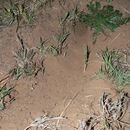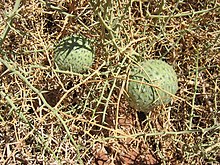tr
kırıntılardaki isimler


Gerbillurus tytonis ye una especie de royedor de la familia Muridae.
Alcuéntrase namái en Namibia.
El so hábitat natural son: desiertos templaos.
Gerbillurus tytonis és una espècie de rosegador de la família dels múrids. És endèmic de l'oest de Namíbia. El seu hàbitat natural són els camps de dunes, incloent-hi les dunes altes (de fins a 300 m) i les dunes fitogèniques. Es creu que no hi ha cap amenaça significativa per a la supervivència d'aquesta espècie.[1] El seu nom específic, tytonis, significa 'de Tyto' en llatí i es refereix al fet que els primers espècimens de G. tytonis foren cranis trobats entre els excrements d'òlibes (Tyto alba).[2]
Gerbillurus tytonis és una espècie de rosegador de la família dels múrids. És endèmic de l'oest de Namíbia. El seu hàbitat natural són els camps de dunes, incloent-hi les dunes altes (de fins a 300 m) i les dunes fitogèniques. Es creu que no hi ha cap amenaça significativa per a la supervivència d'aquesta espècie. El seu nom específic, tytonis, significa 'de Tyto' en llatí i es refereix al fet que els primers espècimens de G. tytonis foren cranis trobats entre els excrements d'òlibes (Tyto alba).
The dune hairy-footed gerbil,[3] or the Namib dune gerbil[1] (Gerbillurus tytonis) is a species of rodent found only in Namibia. Its natural habitat is temperate desert where it lives in loose sand among sand dunes, feeding opportunistically on arthropods, seeds and green vegetation.
The dune hairy-footed gerbil is a moderate-sized Gerbillurus species with a head-and-body length of 99 mm (3.9 in) and a long tail. The head is narrow with a pointed muzzle, large eyes, and long, sparsely-haired ears. The upper parts of the head and body are a rich chestnut, sharply delineated from the underparts, which are white. There is a small white patch above each eye. The legs are white, the forelegs being much shorter than the hind legs. There are five toes on each foot, with the toes of the hind feet being long and flared. All the feet have well-furred soles and a distinctive fringe of hairs on each toe. The tail is very long, being chestnut above and white below, and tipped with a tuft of greyish hairs.[3]

This gerbil is endemic to the deserts of western Namibia, where it occurs in areas with high or low sand dunes, and in dune hummocks.[1] Its range consists of an area near the coast between Swakopmund and Lüderitz. It favours habitats with shifting sand and some plant life, avoiding hard compact dune valley floors. The burrow is often dug beside Trianthema hereroensis or Stipagrostis sabulicola plants, whose roots stabilise the soil, or in the hummocks of spiny growth formed by Acanthosicyos horridus (nara) plants.[3]
The dune hairy-footed gerbil is nocturnal and moves by leaping, being able to cover up to 41 cm (16 in) in a single jump. It keeps cool by day by remaining underground in its burrow. This may be branched, have more than one entrance, and be up to 1 m (40 in) long. Inside the burrow there are caches of food and a nest chamber filled with shredded plant matter. The gerbil's diet includes arthropods and seeds, and green vegetation when available. This gerbil concentrates its urine, and has no need to drink as long as its food is rich in arthropods and does not entirely consist of dry seeds. It maintains the condition of its coat by frequent sand-bathing.[3]
This species is common in its dune habitat. It is presumed to have a large total population and no specific threats have been identified. It is present in some protected areas and the International Union for Conservation of Nature has assessed its conservation status as being of "least concern".[1]
The dune hairy-footed gerbil, or the Namib dune gerbil (Gerbillurus tytonis) is a species of rodent found only in Namibia. Its natural habitat is temperate desert where it lives in loose sand among sand dunes, feeding opportunistically on arthropods, seeds and green vegetation.
Gerbillurus tytonis es una especie de roedor de la familia Muridae.
Se encuentra sólo en Namibia.
Su hábitat natural son: desiertos templados.
Gerbillurus tytonis Gerbillurus generoko animalia da. Karraskarien barruko Gerbillinae azpifamilia eta Muridae familian sailkatuta dago.
Gerbillurus tytonis Gerbillurus generoko animalia da. Karraskarien barruko Gerbillinae azpifamilia eta Muridae familian sailkatuta dago.
Gerbillurus tytonis
La Gerbille des dunes[1] (Gerbillurus tytonis ou Gerbillurus (Paratatera) tytonis) est une espèce de gerbille de la famille des Muridés.
La Gerbille des dunes est endémique de l'ouest de la Namibie.
Gerbillurus tytonis
La Gerbille des dunes (Gerbillurus tytonis ou Gerbillurus (Paratatera) tytonis) est une espèce de gerbille de la famille des Muridés.
Gerbillurus tytonis (Bauer & Niethammer, 1960) è un roditore della famiglia dei Muridi diffuso nell'Africa meridionale.[1][2]
Roditore di piccole dimensioni, con la lunghezza totale tra 205 e 240 mm, la lunghezza della coda tra 113 e 141 mm, la lunghezza del piede tra 28 e 36 mm, la lunghezza delle orecchie tra 12 e 14 mm.[3]
La pelliccia è lunga e arruffata. Le parti superiori variano dal rossastro brillante al bruno, mentre le parti ventrali e le zampe sono bianche. La linea di demarcazione lungo i fianchi è netta. Sono presenti delle macchie bianche sopra ogni occhio e dietro ogni orecchio. Le orecchie sono giallo cannella. La coda è più lunga della testa e del corpo, marrone sopra, bianca sotto e con un ciuffo di lunghi peli grigi all'estremità. Il numero cromosomico è 2n=36.
È una specie terricola e notturna. Si rifugia di giorno in tane profonde.
Si nutre di parti vegetali, artropodi e parzialmente di semi.
Si riproduce durante l'estate.
Questa specie è diffusa nella Namibia occidentale.
Vive nelle dune alte fino a 300 metri.
La IUCN Red List, considerata la vasta distribuzione, la popolazione numerosa e la presenza in diverse aree protette, classifica G.tytonis come specie a rischio minimo (LC).[1]
Gerbillurus tytonis (Bauer & Niethammer, 1960) è un roditore della famiglia dei Muridi diffuso nell'Africa meridionale.
Gerbillurus tytonis is een zoogdier uit de familie van de Muridae. De wetenschappelijke naam van de soort werd voor het eerst geldig gepubliceerd door Bauer & Niethammer in 1960.
Bronnen, noten en/of referentiesGerbillurus tytonis é uma espécie de roedor da família Muridae.
Apenas pode ser encontrada na Namíbia.
Os seus habitats naturais são: desertos temperados.[1]
Gerbillurus tytonis é uma espécie de roedor da família Muridae.
Apenas pode ser encontrada na Namíbia.
Gerbillurus tytonis[2][3] är en däggdjursart som först beskrevs av Bauer och Niethammer 1960. Gerbillurus tytonis ingår i släktet Gerbillurus och familjen råttdjur.[4][5] IUCN kategoriserar arten globalt som livskraftig.[1] Inga underarter finns listade i Catalogue of Life.[4]
Arten förekommer i västra Namibia i en bredare region vid havet. Den lever där i öknar och halvöknar med sanddyner och lite växtlighet.[1]
Denna gnagare blir med svans 20,5 till 24,0 cm lång, svanslängden är 11,3 till 14,1 cm och vikten är ungefär 24 g. Djuret har 2,8 till 3,6 cm långa bakfötter och 1,2 till 1,4 cm stora öron. Hos arten förekommer en tydlig gräns mellan ovansidans rödbruna päls och undersidans vita päls. Dessutom finns vita fläckar kring ögonen och öronen. Svansen har samma uppdelning som kroppen i en mörk ovansida och en vit undersida. Vid svansens spets har håren en grå skugga. Kännetecknande är de långa tårna vid bakfötterna som är utrustade med styva hår. Gerbillurus tytonis har rännor i de övre framtänderna.[6]
Gerbillurus tytonis är en däggdjursart som först beskrevs av Bauer och Niethammer 1960. Gerbillurus tytonis ingår i släktet Gerbillurus och familjen råttdjur. IUCN kategoriserar arten globalt som livskraftig. Inga underarter finns listade i Catalogue of Life.
Arten förekommer i västra Namibia i en bredare region vid havet. Den lever där i öknar och halvöknar med sanddyner och lite växtlighet.
Denna gnagare blir med svans 20,5 till 24,0 cm lång, svanslängden är 11,3 till 14,1 cm och vikten är ungefär 24 g. Djuret har 2,8 till 3,6 cm långa bakfötter och 1,2 till 1,4 cm stora öron. Hos arten förekommer en tydlig gräns mellan ovansidans rödbruna päls och undersidans vita päls. Dessutom finns vita fläckar kring ögonen och öronen. Svansen har samma uppdelning som kroppen i en mörk ovansida och en vit undersida. Vid svansens spets har håren en grå skugga. Kännetecknande är de långa tårna vid bakfötterna som är utrustade med styva hår. Gerbillurus tytonis har rännor i de övre framtänderna.
Gerbillurus tytonis là một loài động vật có vú trong họ Chuột, bộ Gặm nhấm. Loài này được Bauer & Niethammer mô tả năm 1959.[1]
Gerbillurus tytonis là một loài động vật có vú trong họ Chuột, bộ Gặm nhấm. Loài này được Bauer & Niethammer mô tả năm 1959.
모래언덕털북숭이발저빌 또는 나미비아모래언덕저빌(Gerbillurus tytonis)은 황무지쥐아과에 속하는 설치류의 일종이다.[2] 나미비아에서만 발견된다. 자연 서식지는 온대 사막이다.
꼬리 길이 113~141mm를 포함한 전체 몸길이가 205~240mm인 작은 설치류로 발 길이는 28~36mm이고 귀 길이는 12~14mm이다.[3] 길고 헝크러진 털을 갖고 있다. 등 쪽은 밝고 불그스레한 색부터 갈색까지 띠는 반면에 배 쪽과 다리는 희다.
땅 위에서 주로 생활하는 육상성 동물이고, 야행성 동물이다. 낮 동안에는 깊은 굴 속에 피신한다. 먹이는 식물과 절지동물이고 부분적으로 씨앗이다. 여름에 번식을 한다.
나미비아 서부에 널리 분포한다. 최대 300m의 모래 언덕에서 서식한다.